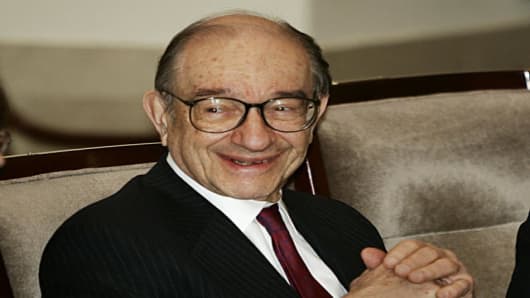Though it may not seem like much by the relatively loquacious and candid ways of his successor Ben Bernanke, Alan Greenspan made the Federal Reserve more transparent than his predecessors – even if his speeches and official testimony were memorably obtuse.
“Greenspan spoke in riddles,” says David Resler, chief economist and managing director of
Nomura Securities International. “It was up to us to decipher. Bernanke’s not coming up with ambiguous ways to state the facts.”
Greenspan's legacy is once again a topic of debate with the Sept. 17 release of his highly-anticipated book, "The Age Of Turbulence: Adventures In A New World".
The Fed had long been a mysterious institution when Greenspan assumed the chairmanship. For decades, and even in the early part of the Greenspan era, the Fed never actually announced its policy moves. Market watchers were left to interpret and guess what its target was for the federal funds rate.
Even with all of his rate increases to fight inflation, Paul Volcker – who ran the Fed from 1979-1987 and generally edges out Greenspan as the best to hold the post -- was famous for manipulating money supply to stoke or cool the economy, like the way a carburetor feeds gasoline to an engine.
“The Fed generally doesn’t like to be transparent,” says Lawrence White of NYU’s Stern School of economics, who served as both an economist and regulator for the federal government, suggesting that Greenspan’s approach was status quo.
Nevertheless, in February 1994, the Greenspan Fed made history by publicly announcing a rate move for the first time. (Click here for other major events in the Greenspan area.) Resler says Greenspan may have been “testing the waters” with that stunning move but gives him “high marks for moving closer to greater disclosure.”
During that era, Congress had its own problems with Fed policy and eventually forced the central bank to disclose more information. The period between the Fed’s monetary policy meetings and the release of the minutes was shortened but it wasn’t until 1999 that the Fed regularly issued policy statements after each meeting.
Yet, despite the criticism and gentle kidding about Greenspan’s manner of communication, most say it worked.
“If you really listened to him, you got the message,” adds James Awad, chairman of WP Stewart Asset Management, which manages more than $6 billion in large cap growth stocks. “It took a lot of work.”
Fed watcher and author David Jones of DMJ Advisors cites Greenspan’s tightening campaign of 1994-1995 as a “perfect moment” of transparency. His easy money period of 2003-2004 can also be seen as very transparent in the sense that the continued appearance of such key words and phrases as “patient” and “accommodation can be maintained for a considerable period” in Fed statements telegraphed policy for the markets. As a result, there was little volatility around the Fed’s meetings.
Progress aside, Greenspan does have his detractors in this area, a position summed up well by Robert Brusca, chief economist at Fact And Opinion Economics.
“Greenspan went out of his way to be murky and not communicate very well,” says Brusca. “At the same time he got the markets to believe he was a champion of transparency.”
Now that’s Fed speak.




